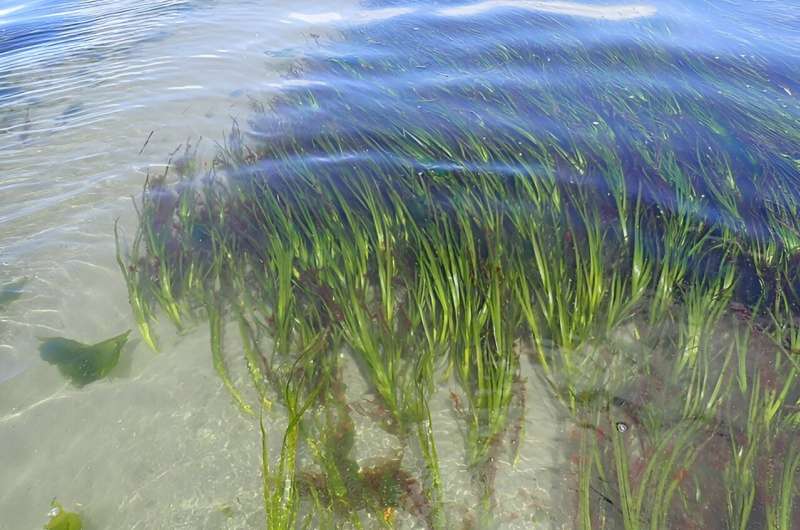This article has been reviewed according to Science X's editorial process and policies. Editors have highlighted the following attributes while ensuring the content's credibility:
fact-checked
reputable news agency
proofread
Survey of nature's superhero, eelgrass, kicks off California bridge project

Two researchers in an inflatable boat glided out onto Batiquitos Lagoon in Carlsbad, California, August 15, looking for eelgrass, an underwater plant that provides a nursery for fish, crabs, shrimp and other sealife.
The boaters, equipped with sonar and diving gear, also were looking for any sign of Caulerpa, an invasive seaweed that can spread rapidly and choke out the native eelgrass. Nicknamed "killer algae," Caulerpa taxifolia turned up in Carlsbad's nearby Agua Hedionda Lagoon in 2000 and was eliminated only after an intensive, multi-year, $7 million battle.
Since then, the invader, which may have been dumped from a home aquarium, has been absent along the North County coastline. However, last year, small amounts of a slightly different but equally destructive species, Caulerpa prolifica, were found in San Diego Bay and efforts are underway to eradicate it.
The one-day Carlsbad survey is part of the preparations for replacing the 80-year-old wooden railroad trestle that crosses the lagoon. Construction is expected to begin this fall and be completed in 2028 at a cost of about $165 million. State law requires construction to pause from April 15 to July 31 each year during the California least tern nesting season.
A survey in 2015 showed several dense beds of eelgrass spread between a few sparse areas in the lagoon, said Derek Langsford, an environmental compliance consultant working with the San Diego Association of Governments.
Eelgrass is considered one of nature's superheroes. One of many species of seagrass, its long, slippery blades offer shade and camouflage for young fish. Eelgrass anchors shorelines and provides food and habitat for a variety of marine life.
Growth of the perennial plant varies from year to year depending on the weather, rainfall and other factors.
"We've had two relatively wet winters," Langsford said. "That brings more freshwater flowing through the channel of the lagoon. Eelgrass does not like freshwater."
Storm runoff also brings silt and sediment, which cloud the water and prevent light from reaching the plant for the photosynthesis it needs to survive.
"These lagoons are very sensitive, and they support a bunch of endangered species," said Sue Scatolini, a biologist at the California Department of Transportation, or CalTrans. "Salt marsh and lagoon habitats are very important."
More than 200 species of birds have been seen at the lagoon, including the endangered California least tern and the western snowy plover. The shallow water is a breeding ground for biologically and commercially important ocean fish such as halibut and sculpin.
Other than eelgrass, there's not a lot of vegetation in the lagoon, Scatoline said. Most of the bottom is shallow and sandy, much of it only knee deep at low tide. The deepest part is the channel under the bridge, where the bottom is scoured by the current.
Eelgrass is a flowering underwater plant, not seaweed, that grows in areas from the tidal zone down to about 20 feet deep.
Native Americans collected it for food, roofing, basket weaving, smoking deer meat and as a cure for diarrhea. Early California settlers used it to thatch their roofs, as well as for fuel, bedding and a soil conditioner.
Industries have used eelgrass to make paper, cigars, upholstery and packing materials. However, today state law prohibits its commercial or recreational harvest, according to the state Department of Fish and Wildlife.
The San Diego Association of Governments, which oversees the bridge replacement project, will be required to replace any eelgrass that the survey finds growing in the area affected by construction. Should any Caulerpa be discovered, construction could be delayed until the invasive plant is removed.
"We don't think we will encounter any Caulerpa here," said Tim Pesce, a senior environmental planner for SANDAG.
The old, single-track railroad bridge is being replaced with a double-track concrete bridge that brings numerous environmental and operational benefits.
The new bridge will be longer with less of a footprint in the water, which will improve tidal flows and water quality in the lagoon. Instead of standing on more than 100 closely spaced wooden posts or piers in the water, the new structure will be supported by concrete piers set 56 feet apart.
Another benefit will be the excavation of about 40,000 cubic yards of sand, Pesce said. The sand will be used to replenish nearby South Ponto Beach and to expand an eroding least tern nesting area near the mouth of the lagoon.
As for operational benefits, a second set of tracks improves the speed and efficiency of the service by allowing trains to pass each other.
So far, SANDAG has double-tracked about three quarters of the 60-mile corridor from downtown San Diego to the Orange County border. The Batiquitos bridge project will add more than half a mile of double-track, eliminating a bottleneck between Carlsbad and Encinitas.
The bridge project strengthens an important link in the 351-mile Los Angeles-San Diego-San Luis Obispo, or LOSSAN, rail corridor.
The LOSSAN corridor is San Diego County's only passenger and freight train connection with Los Angeles and the rest of the United States. It's also part of the federal Strategic Rail Corridor Network connecting military bases across the country.
Locally, the corridor is used daily by North County Transit District's Coaster commuter trains, Amtrak passenger service, and BNSF Freight.
2024 The San Diego Union-Tribune. Distributed by Tribune Content Agency, LLC.





















